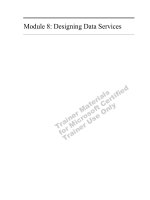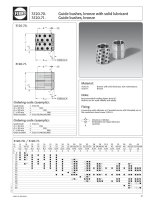Pw 8 designing parts for ultrasonic degating
Bạn đang xem bản rút gọn của tài liệu. Xem và tải ngay bản đầy đủ của tài liệu tại đây (861.89 KB, 4 trang )
<span class="text_page_counter">Trang 1</span><div class="page_container" data-page="1">
<b>General Description: The </b>
sepa-ration of injection-molded parts from their runner systems through the introduction of ultra-sonic energy into the area of the gate is referred to as ultrasonic degating. These gate sections, when ultrasonically excited, reach high temperatures and melt due to a high degree of intermolecular excitation and internal friction.
This information sheet describes ultrasonic degating and provides design guidelines for its use. The advantages of ultrasonic degating include:
• Speed of operation, with a typical cycle time of less than one second.
• No stress developed in plastic component.
• A clean break at the part surface with minimal vestige.• Many parts may be simultane-
ously degated and cally separated into bins.
<b>automati-Mechanics of Ultrasonic Degating</b>
The vibrating horn contacts the runner as closely to the part as possible with relatively light force, generally 20 to 40 pounds, imparting maximum energy into the runner system. The mechani-cal vibrations generate a stand-ing wave of energy down the runner through the gate area and into the part. (Refer to Figure 1.)The freely resonating part goes through cyclic bending moment with the gate area acting as the fulcrum.
<i><b>Designing Parts for Ultrasonic Degating</b></i>
<b>Ultrasonic TechnologiesTechnical Information </b>
<i><small>Figure 1. Standing wave of mechanical vibration during degating.</small></i>
</div><span class="text_page_counter">Trang 2</span><div class="page_container" data-page="2">This bending induces stress into the already highly-stressed gate area and generates internal molecular friction (hysteresis losses) which rapidly elevates the temperature of the material at the localized area of the gate. Once the melt tempera-ture is reached, the part falls free of the runner.
<b>Primary Factors Influencing Design</b>
The following questions should be addressed prior to designing for ultrasonic degating:
<i>What type of material is to be used?</i>
Rigid thermoplastic materials (polystyrene, ABS, polycarbonate, acrylic, nylon, etc.) work best. They transmit the mechanical energy more efficiently.
Lower stiffness (modulus) plastics such as polyethylene and polypropylene absorb the mechani-cal energy and do not give good consistent results.
<i>thermo-What is the part size/mass?</i>
Generally parts of smaller size and mass are better suited for ultrasonic degating. Large, massive parts require excessive energy to over-come inertia.
Brittle thermoplastics tend to ture from the mechanical vibrations instead of melting. Thermosets, of course, do not melt at all, but a mechanical break is still possible.
<b>frac-Major Design Characteristics</b>
In order to obtain acceptable, repeatable results, these general guidelines must be followed:1. The gate area must be designed
to focus the vibratory energy to a point tangent to the surface of the part (see figure 2). This is done with a conical profile for circular parts or a pyramid profile for rectangular parts (all sides must be tapered). The design shown in Figure 3 does not properly focus the energy
<i><small>Figure 2. Correct gate design.Figure 3. Incorrect gate design.</small></i>
<i>Designing Parts for Ultrasonic Degating</i>
</div><span class="text_page_counter">Trang 3</span><div class="page_container" data-page="3">and could allow a section of the gate to remain on the part.2. Any gate cross-section that can
fit into an 0.080 inch (2.03 mm) diameter circle can be ultrasoni-cally degated (see Figure 4.). Circular gates give the best results due to their uniform melt. Rectangular gates should not exceed 0.015 inch (0.4 mm) thickness by 0.080 inch (2.03 mm) width.
<b>Horn Design and Placement</b>
Standard horns can be used for some degating jobs, but best results usually are obtained with a horn that is custom-made for use with a particular runner system. Contact between runner and horn should be maximized, so that energy is transferred efficiently.Horn width should at least equal runner width. Flat-faced horns are recommended for flat-topped runner systems such as those with
rectangular or trapezoidal sections. Round or oval runners require horns that are contoured to that shape. Some horns also have to be relieved in spots to accommodate bosses, sprues or other raised areas on the runners (see Figure 5.).
cross-Horn length should ideally equal the length of the runner leg being degated, because most plastics do not transmit ultrasonic energy well enough to permit degating at points over 3 to 4 inches from the horn extremities. Many runner systems are small enough to be handled with a single placement of a large bar horn. For large runner systems, or those with several branches (balanced runner systems), more than one horn placement may be necessary (see Figure 6).
This could be done automatically by using a sliding fixture that moves the runner relative to the horn.
<i><small>Figure 4. Gate size.Figure 5. Maximizing horn-to-part surface area for best results</small></i>
<i><small>Figure 6. Horn size and replacement.</small></i>
</div><span class="text_page_counter">Trang 4</span><div class="page_container" data-page="4"><b>Technical Information</b>
<small>PW-8 © Branson Ultrasonics Corporation 1999</small>
<small>The Emerson logo is a trademark and service mark of Emerson Electric Co. Revised and printed in the U.S.A. 6/11</small>
<b>Ultrasonic Technologies</b>
<i><small>Branson Ultrasonics Corporation 41 Eagle Road, Danbury, CT 06813-1961 (203) 796-0400 • Fax: (203) 796-9838 www.bransonultrasonics.com e-mail: Quaker Meeting House Rd., Honeoye Falls, NY 14472 </small></i>
<i><small>(585) 624-8000 • Fax: (585) 624-1262</small></i>
In many cases a sheet of resilient material such as urethane is placed beneath the runner system to insure an out-of-phase relation-ship between the runner and horn surface. If this sheet is not used, the part vibrates in phase with the horn, and very little heat is generated. The durometer of the material can also influence the results, making it necessary to try different materials to optimize the process.
<b>Equipment Parameters: Some </b>
development time may be necessary to arrive at the equip-ment parameters that will produce the desired results for each type Alternatively, more than one horn
can be used simultaneously, or a non-rectangular horn face can be used. For example, a circular horn has been used to remove parts from a radial runner system.
<b>General Operating ParametersFixturinG: Along with the horn, </b>
fixturing is a very important process variable. The fixture must support the runner system properly, so that it does not interfere with the transmission of the mechanical vibrations; in some cases the fixture may enhance transmission. Rigid support materials such as aluminum or stainless steel should be used to construct the fixture.
of part and material. In general, however, a good starting point would be:
</div>








